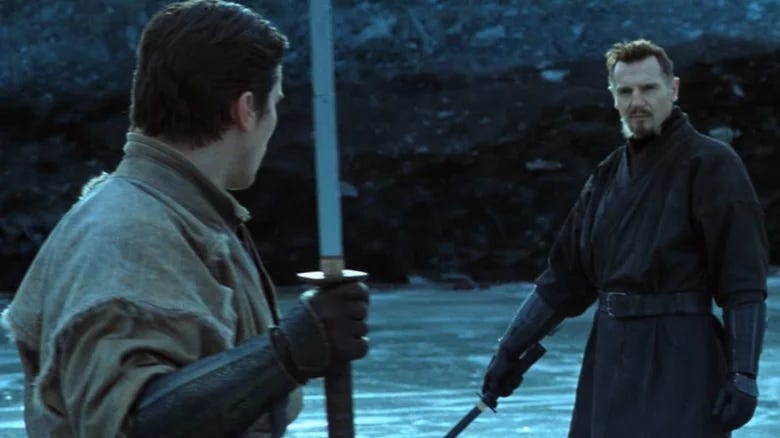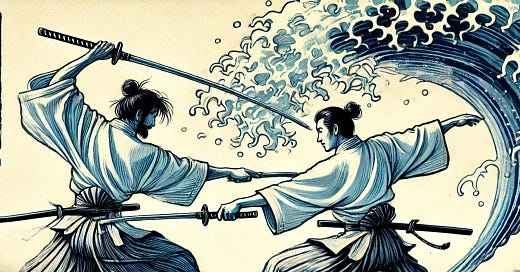It’s one of those suffocating, wet Saturdays at the dojo. The kind where the air feels heavy, like it’s pressing down on you with every breath. The rusted fans wheeze in the corners, barely moving the thick air. We sweat through our kendogi, the black fabric sticking to our backs, but no one complains. We are running through a drill that chains technique after technique, each move feeding into the next. No breaks, no pauses. Efficiency is everything. We think we are doing great. Fluid. Martial. Badass.
“Yame!”1
The sensei’s voice cuts through the room. We freeze, swords mid-air, waiting for the scolding. We understand we are off, but we don’t get why —yet.
“What the hell are you doing? A dance recital?” His voice is sharp. He doesn’t wait for us to answer. Suddenly, he lunges—fast and brutal. I see it coming and use the deflective technique we have been practicing. I cannot stop it. My sword slips, useless, and his blade’s tip rests now against my left temple.
“Dead,” he says.
“What just happened?” he asks. A hesitant voice from the back: “You used a wrong form of attack, not what you taught us in kihon2.”
“Kihon?” the sensei repeats, looking at the guy. “Ángel’s dead. I’m alive. Where’s the problem?”
Kihon—the word hangs in the air. It means “fundamentals,” the building blocks of every martial art. But the way he says it, you can hear the disdain. “Kihon,” he continues, “isn't the core of Kenjutsu. The core of Kenjutsu is surviving your opponents, winning the war. You think your perfect form will save you? Do you expect the enemies who want to kill you to be gentle—use beautiful, predictable kihon against you?”.
I laugh, amused. Because we are not warriors, but recital dancers—and we suck. But also because I had an awful week and suddenly find this new idea… comforting.
Bad product kihon?
A few days earlier, I was back at my desk after a long leave. Same heat, but that time in the form of emails and Slack messages—all stacked up, each one another blow. Criticism. Complaints. No roadmap updates, no prep before a feature launch, outages. Fingers pointed backward, always in hindsight. My team and I weren’t following best practices.
Very bad product kihon.
I didn’t take it personally. They weren’t wrong. I’d let some things slip. I could have done more, better. And even if it wasn’t that simple, I owned it.
The question gnawed at me, though. Could I have done something different if I knew what I know now? Sure. One can always do better. But most likely not much. The truth was, in the last months we hadn’t been managing a product—we’d been surviving. Best practices? Kihon. Fundamentals. They’re great until your back’s against the wall, until you’ve got to choose between the perfect decision and the one that keeps you standing.
That’s the thing no book or guru tells you. You can master the basics, create flawless processes, build a perfect quarterly plan. And sure, you can craft a solid business case, design a sleek architecture, create the leanest UX and share a beautiful GTM plan with the stakeholders. But if your soil’s crumbling beneath you and a pack of orcs is charging with scimitars, you’re damn going to make trade-offs. Life isn’t a dojo. It’s messy. You think there’s time to refine your moves, but there isn’t. You’re fighting for your throat:
There are deadlines to meet;
customers who can walk away;
opportunities that can be missed.
So what?
In the real world, there’s no award for following the playbook while everything crumbles around you. You either win, or you don’t. And winning, like the sensei demonstrated, has nothing to do with perfect form. It’s about cutting corners before the upcoming challenges cut you down.
The point isn’t to be the best— at least not always. Sometimes, the point is to deliver immediate value and win business opportunities for your company.
So, am I giving you a wild-card to stay messy and sloppy?
God forbid.
This is not an excuse for not pursuing excellence. It’s the acknowledgement of a painful reality.
But be cautious! Over time, this operating mode accumulates into technical debt or compromises the long-term vision. Ultimately, customer-centricity and long-term growth must not be forgotten. A short-term win might also hurt in the long run.

Miyamoto Musashi, the legendary samurai who was never defeated, knew that. The guy who walks away alive isn’t always the one with the cleanest technique, but the one who’s willing to do whatever it takes to walk away at all.
Never lose that edge.
Yame.
Japanese command, "stop".
Fundamental techniques and principles of a martial art.






Angel, I'm thrilled to read you!.... I really enjoy your writing, the passion, and great content you put into your blog, both entertaining and professional.
Keep up, Product world needs you!